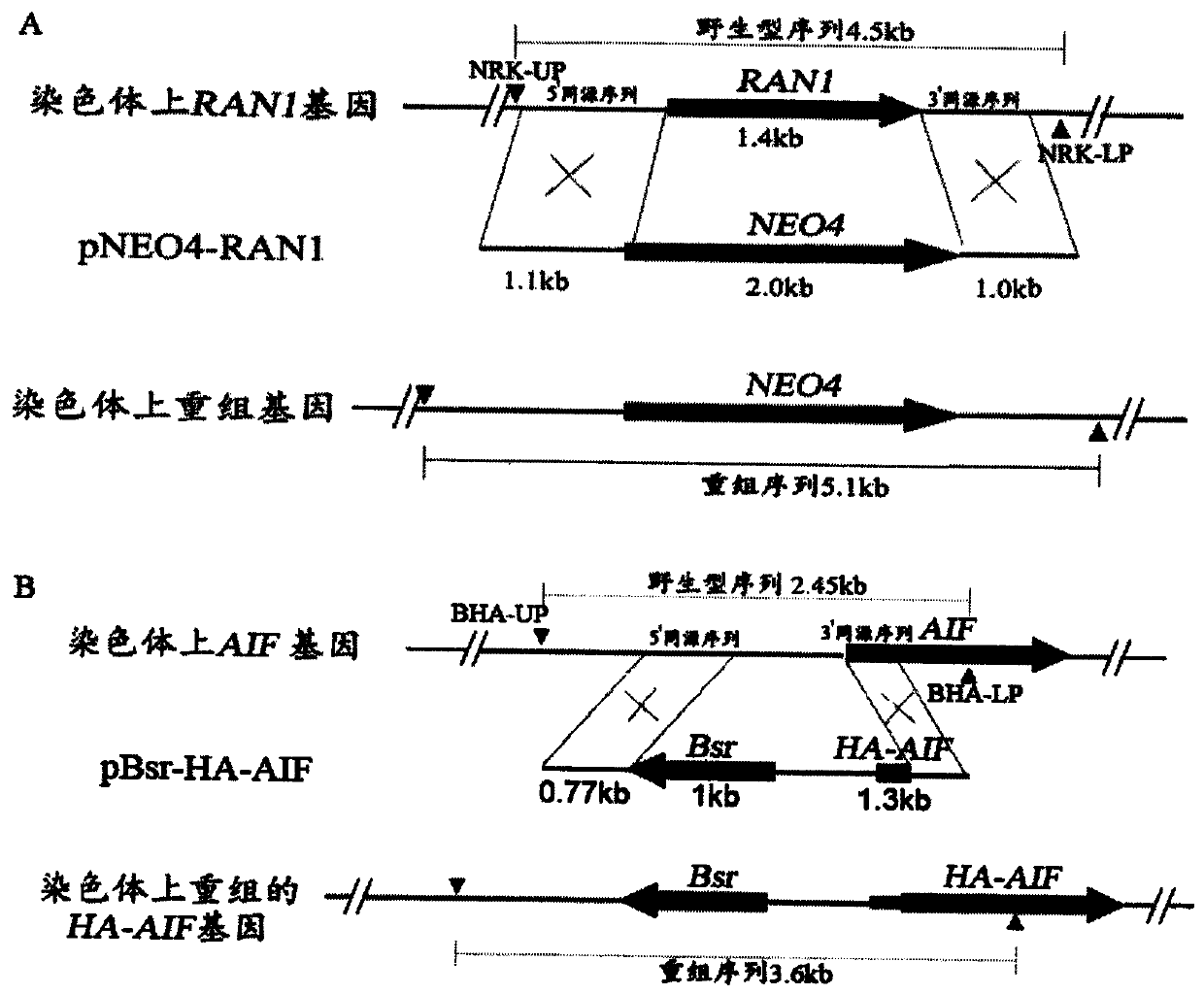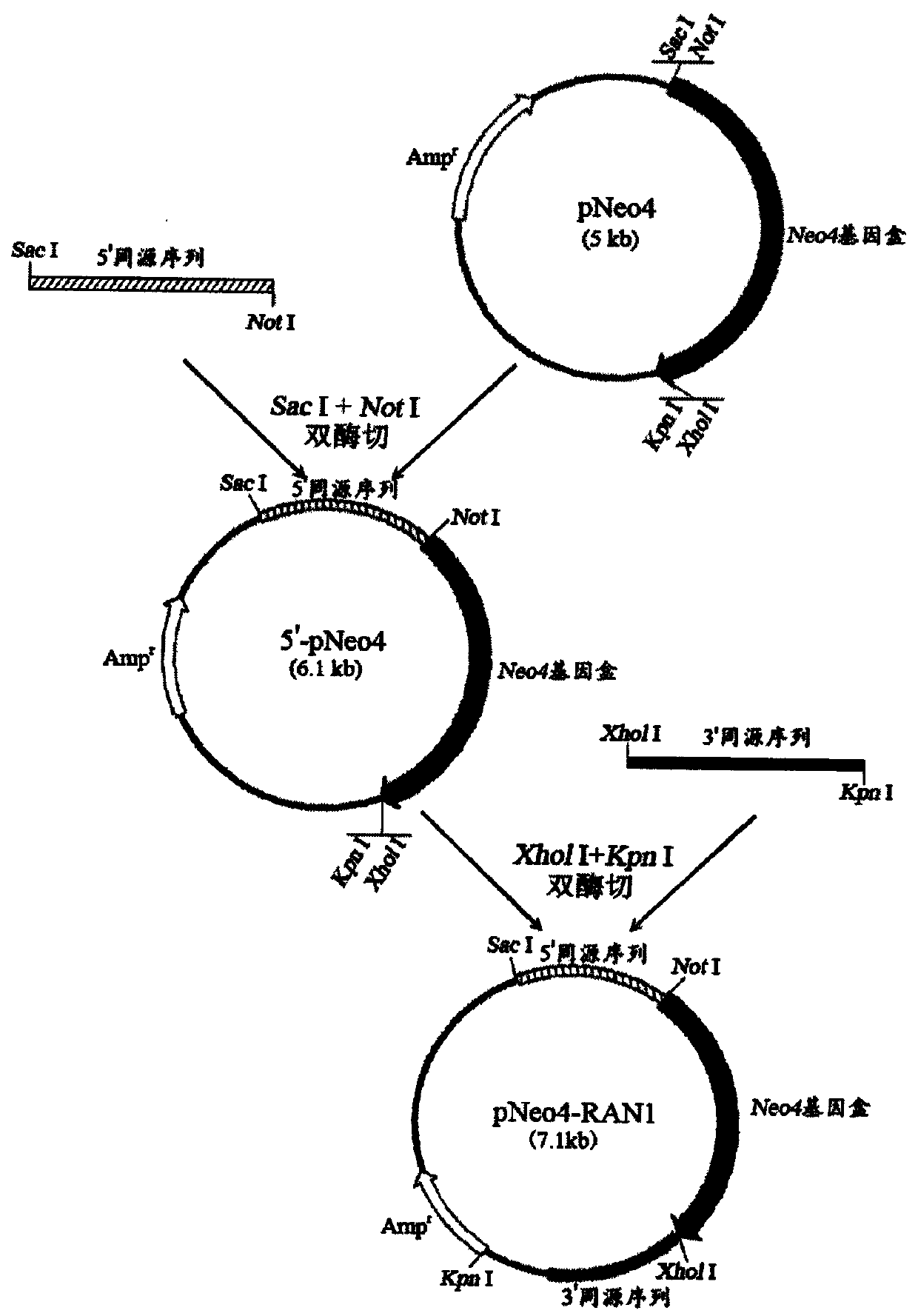A method for constructing a multi-gene transfected Tetrahymena thermophila cell line and its application
A technology of Tetrahymena thermophila and a construction method, which is applied to the construction of a multi-gene transfected Tetrahymena thermophila cell line. The method is applied in the multi-gene joint research of Tetrahymena, and can solve problems such as inability to survive.
- Summary
- Abstract
- Description
- Claims
- Application Information
AI Technical Summary
Problems solved by technology
Method used
Image
Examples
Embodiment 1
[0066] Example 1. Construction of plasmid pBsr
[0067] 1. PCR amplification of Bsr gene cassette sequence. The upstream and downstream primers are: 5′ GCGGCCGC GCATCTGGTGAGATATCTTCAAAGT-3' (the underlined part is the Not I restriction site), 5' CTCGAG ATCATGATGGAAAATAAAACCATGCA-3' (the underlined part is the Xho1 I restriction site), the template is pMNBL plasmid (gifted by Dr. Martin A. Gorovsky, University of Rochester, preserved in our laboratory), the amplification conditions are: 94℃3min; 94℃30s, 51℃30s, 68℃1min10s, 30 cycles; 68℃5min. 1.0% agarose gel electrophoresis analysis of the amplified product is about 1.1 kb, a large amount of amplification and recovery of the target band (refer to BioFlux's DNA gel recovery kit manual for the gel recovery process), and sequencing to identify the Bsr gene cassette sequence. See attached for electrophoresis results figure 1 B.
[0068] 2. Digest the Bsr gene cassette and pNeo4 separately. (1) The Bsr gene cassette sequence was di...
Embodiment 2
[0070] Example 2. Construction of gene targeting recombinant plasmid pNeo4-RAN1
[0071] The Neo4 gene cassette partially replaces the wild-type RAN1 gene on the large nuclear chromosome through the homologous recombination guided by the pNeo4-RAN1 recombinant plasmid, thereby achieving the purpose of knocking down the wild-type RAN1 gene. See attached for homologous recombination strategy figure 2 A, see attached diagram for construction image 3 .
[0072] 1. PCR amplification of 5'homologous sequence: 5'flanking sequence of RAN1 gene. The upstream and downstream primers are: 5′- GAGCTC ATTTACAATTATGCCATCTTCAT-3' (the underlined part is the Sac I restriction site), 5'- GCGGCCGC TTGTCTTCTGCCTTAACACACTA-3' (the underlined part is the Not I restriction site), the template is Tetrahymena genomic DNA, the amplification conditions are: 95℃ 3min; 95℃ 30s, 48℃ 30s, 68℃ 1 min, 30 Cycle; 68°C for 5 min. 1.0% agarose gel electrophoresis analysis of the amplified product is about 1.1 kb...
Embodiment 3
[0075] Example 3. Transfection of wild-type Tetrahymena with gene targeting recombinant plasmid pNeo4-RAN1 and screening and identification
[0076] 1. Transfect wild-type Tetrahymena cells with pNeo4-RAN1.
[0077] (1) Linearization and concentration of gene targeting recombinant plasmid pNeo4-RAN1. The plasmid pNeo4-RAN1 was linearized by double digestion with Sac I and Kpn I, and the linearized fragment was concentrated to a concentration of 1 to 1.5 μg / μL.
[0078] (2) Cultivation of Tetrahymena. Take the wild type (Wild Type, WT) Tetrahymena thermophila CU428 and B2086 of different mating types that grow well and inoculate them in 50 mL SPP liquid medium (SPP liquid medium preparation method: use sterilized ultrapure water) 10× storage mother liquor, which contains 1% tryptone, 3‰ EDTA, 0.1% yeast extract, 1% prion protein, 0.2% glucose, autoclaved at 120℃ for 20 min, stored at -20℃, working concentration is 1×) , Make the initial concentration 0.1~0.5×10 4 cells / mL, incubate...
PUM
 Login to View More
Login to View More Abstract
Description
Claims
Application Information
 Login to View More
Login to View More - R&D
- Intellectual Property
- Life Sciences
- Materials
- Tech Scout
- Unparalleled Data Quality
- Higher Quality Content
- 60% Fewer Hallucinations
Browse by: Latest US Patents, China's latest patents, Technical Efficacy Thesaurus, Application Domain, Technology Topic, Popular Technical Reports.
© 2025 PatSnap. All rights reserved.Legal|Privacy policy|Modern Slavery Act Transparency Statement|Sitemap|About US| Contact US: help@patsnap.com



